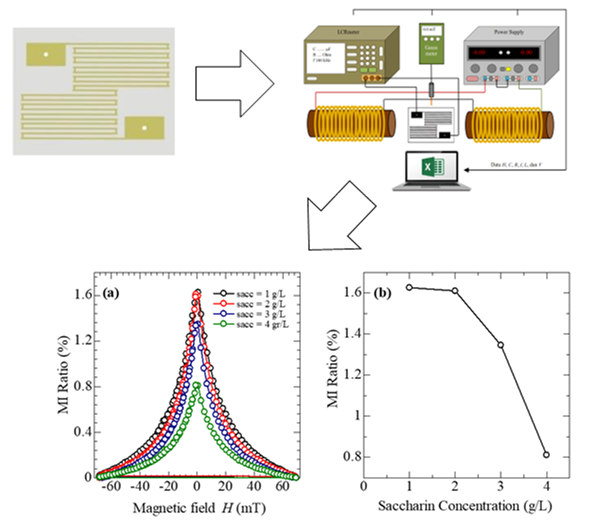Saccharin Dependence of Magnetoimpedance Ratio in Electrodeposited Permalloy Multilayer Structure on Meandered-Copper Printed-Circuit-Board Substrates
DOI:
https://doi.org/10.48048/tis.2023.6695Keywords:
Electro-deposition, Magneto-impedance, Multilayer, NiFe, Cu PCB, Meander, SaccharinAbstract
The effect of saccharin concentration on magnetoimpedance ratio in multilayer permalloy structure i.e., [NiFe/Cu/NiFe]3/Cu/[NiFe/Cu/NiFe]3 on Cu printed circuit board (PCB) meander substrates have been discussed. The multilayer [NiFe/Cu/NiFe]3/Cu/[NiFe/Cu/NiFe]3 structure was prepared by using the electrodeposition method. The results of XRF characterization show that the composition of Ni:Fe is close to the calculation mol ratio permalloy of 80:20. The magnetoimpedance effect is evaluated by total impedance measurement at the various magnetic fields. The typical increase of the magneto-impedance ratio with frequency confirms in this experiment. Here, the magnetoimpedance ratio modifies from 0.07 to 1.63 % for frequency measurements of 20 and 100 kHz, respectively. Finally, the MI ratio monotonically decreases with an increase in additive saccharin concentration. The MI ratio slightly decreases by 17.17 % (=(1.63-1.35)/1.63) for additive saccharin concentration increase of 1 to 2 g/L. Then MI ratio drastically decreases by 40.0 % (=(1.35-0.81)/1.35) in the change of additive saccharin concentration from 2 to 4 g/L. Here, the change in the morphological surface should attribute to the decrease in the MI ratio.
HIGHLIGHTS
- Multilayer [NiFe/Cu/NiFe]3/Cu/[NiFe/Cu/NiFe]3 structure on Cu PCB meander substrates has been successfully fabricated by electrodeposition procedure.
- The magneto-impedance effect of the multilayer samples has been successfully showed at low frequency of ~kHz order.
- The saccharine as an additive material for electrodeposition procedure can modify the magneto-impedance effect of the multilayer sample.
GRAPHICAL ABSTRACT

Downloads
Metrics
References
A Sayad, SM Uddin, J Chan, E Skafidas and P Kwan. Meander thin-film biosensor fabrication to investigate the influence of structural parameters on the magneto-impedance effect. Sensors 2021; 21, 6514.
A García-Arribas, E Fernández, A Svalov, GV Kurlyandskaya and JM Barandiaran. Thin-film magneto-impedance structures with very large sensitivity. J. Magn. Magn. Mater. 2016; 400, 321-6.4
A Sayad, E Skafidas and P Kwan. Magneto-impedance biosensor sensitivity: Effect and Enhancement. Sensors 2020; 20, 5213.
K Wang, S Tajima, Y Asano, Y Okuda, N Hamada, C Cai and T Uchiyama. Detection of P300 brain waves using a magneto-impedance sensor. Int. J. Smart Sens. Intell. Syst. 2014; 7, 1-4.
Y Wang, Y Wen, F Song, P Li and S Yu. Enhanced inductance in laminated multilayer magnetic planar inductor for sensitive magnetic field detection. Appl. Phys. Lett. 2018; 112, 182403.
O Thiabgoh, T Eggers, SD Jiang, JF Sun and MH Phan. Condition monitoring and failure prediction of gear rotation using a contactless RF magnetic sensor. J. Electron. Mater. 2019; 48, 4000.
MH Phan and HX Peng. Giant magnetoimpedance materials: Fundamentals and applications. Progr. Mater. Sci. 2008; 53, 323-420.
B Li, MN Kavaldzhiev and J Kosel. Flexible magnetoimpedance sensor. J. Magn. Magn. Mater. 2015; 378, 499-505.
LV Panina and K Mohri. Magneto-impedance in multilayer films. Sensor. Actuator. Phys. 2000; 81, 71.
Z Zhou, Y Zhou and Y Cao. The investigation of giant magnetoimpedance effect in meander NiFe/Cu/NiFe film. J. Magn. Magn. Mater. 2008; 320, e967.
T Wang, L Guo, C Lei and Y Zhou. Detection of the magnetite by giant magnetoimpedance sensor. Mater. Lett. 2015; 158, 155-8.
H Kikuchi, M Tanii and T Umezaki. Effects of parallel and meander configuration on thin-film magnetoimpedance element. AIP Adv. 2020; 10, 015334.
ASD Melo, F Bohn, A Ferreira, F Vaz and MA Correa. High-frequency magnetoimpedance effect in meander-line trilayered films. J. Magn. Magn. Mater. 2020; 515, 167166.
T Wang, Y Zhou, C Lei, J Lei and Yang, Z. Development of aningenious method for determination of Dynabeads protein A based on agiant magnetoimpedance sensor. Sensor. Actuator. B Chem. 2013; 186, 727.
V Oktaria and B Purnama. Influence of multilayer number to magnetoimpedance ratio in electrodeposited [NiFe/Cu]N Multilayer. Key Eng. Mater. 2020; 855, 191-6.
DA Rusydan, CT Putra, AD Sutomo and B Purnama. Magnetoimpedance effect in symmetry and non-symmetry multi lapisans [Ni80Fe20/Cu]x/Cu/[Ni80Fe20/Cu]6-x on PCB Cu substrate. J. Phys. Conf. Ser. 2021; 1951, 012025.
AC Mishra, T Sahoo, V Srinivas and AK Thakur. Microstructure, magnetic, and magnetoimpedance properties of electrodeposited NiFe/Cu and CoNiFe/Cu wire: A study on influence of saccharin additive in plating bath. J. Appl. Phys. 2011; 109, 073901.
S Esmaili, ME Bahrololoom and Zamani, C. Electrodeposition of NiFe/Cu multi lapisans from a single bath. Surf. Eng. Appl. Electrochem. 2011; 47, 107-111.
A Salman, R Sharif, K Javed, S Shahzadi, KT Kubra, A Butt, S Saeed, H Arshad, S Parajuli, J Feng. Controlled electrochemical synthesis and magnetic characterization of permalloy nanotubes. J. Alloy. Comp. 2020; 836, 155434.
Y Han, X Li, WX Lv, WH Xie, Q Zhao and ZJ Zhao. Magnetoimpedance effect of FINEMET ribbons coated with Fe20Ni80 permalloy film. J. Alloy. Comp. 2016; 678, 494-8.
B Subramanian, K Govindan, V Swaminathan and M Jayachandran. Materials properties of electrodeposited NiFe and NiCoFe coatings. Trans. IMF 2009; 87, 325-9.
SH Kim, HJ Sohn, YC Joo, WE Kim, TH Yim, HY Lee and T Kang. Effect of saccharin addition on the microstructure of electrodeposited Fe-36 wt.% Ni alloy. Surf. Coat. Tech. 2005; 199, 43-8.

Downloads
Published
How to Cite
Issue
Section
License
Copyright (c) 2023 Walailak University

This work is licensed under a Creative Commons Attribution-NonCommercial-NoDerivatives 4.0 International License.






